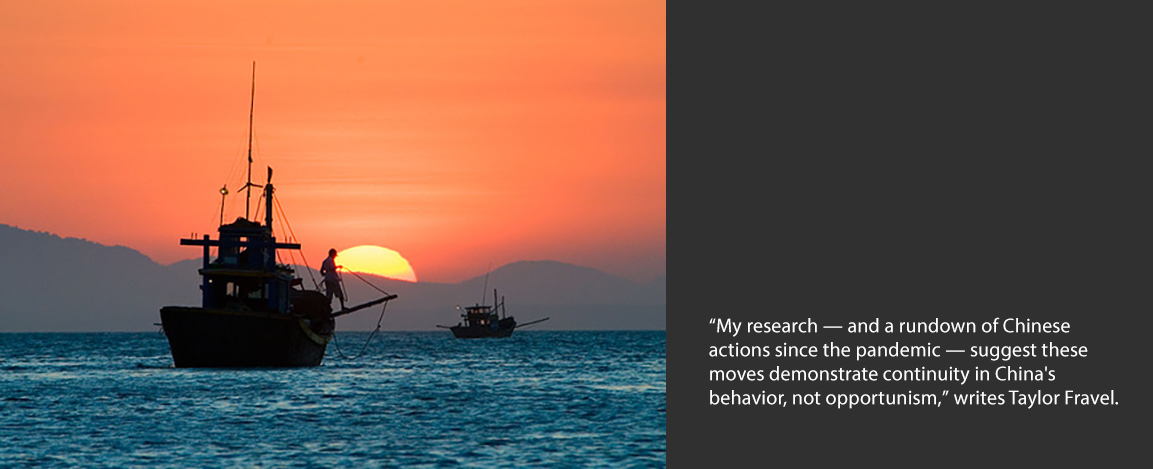A number of recent analyses have emphasized that China is seizing pandemic-created opportunities to improve its position in the South China Sea as other countries are distracted or otherwise unable to respond. Here's what you need to know, explains Taylor Fravel in a recent online opinion piece in The Washington Post.
The South China Sea is becoming even choppier. Last month, China started to conduct a seismic survey within Malaysia's exclusive economic zone (EEZ), and a Vietnamese fishing boat sank near the Paracel Islands after a collision with a China Coast Guard vessel.
A number of recent analyses have emphasized that China is seizing pandemic-created opportunities to improve its position in the South China Sea as other countries are distracted or otherwise unable to respond. A key implication of such claims is that absent the pandemic, China would have acted differently and perhaps with more restraint.
My research—and a rundown of Chinese actions since the pandemic—suggest these moves demonstrate continuity in China's behavior, not opportunism. Here's what you need to know.
1. China's South China Sea strategy hasn't changed
Before the pandemic, China's recent actions in the South China Sea have sought to assert historic rights in these waters. But the idea of historic rights clashes with the definition of the EEZ under the U.N. Convention on the Law of the Sea, which gives coastal states the exclusive right to resources in a zone 200 nautical miles from their shores. In 2016, a tribunal formed to hear a case brought by the Philippines ruled that any claim to historic rights in the South China Sea (implied by the "nine-dash line" on Chinese maps) was invalid.
When rejecting the tribunal's ruling, Beijing doubled down by issuing a rare government statement that openly declared that "China has historic rights in the South China Sea." Although Beijing has not yet defined the content of these rights, they probably focus on "fishing rights, navigation rights and priority rights of resource development," according to one authoritative Chinese analyst.
To assert these historic rights in the past few years, China uses the three large forward-operating bases it created atop reefs in the Spratly Islands through vast land reclamation in 2014-2015, to enhance its physical presence and power projection in these waters.
2. These latest altercations precede the pandemic
In December 2019, China and Indonesia faced off over a Chinese fishing fleet operating near Indonesia's Natuna Island in the far southwestern reaches of the South China Sea. The standoff continued through the end of January, with China Coast Guard ships escorting Chinese fishing vessels as well as displays of resolve by Indonesia's armed forces.
The confrontation between China and Indonesia was only the most recent example of a much longer struggle over fishing in these waters, which began to increase in 2016. China considers the area to be its traditional fishing grounds. But the waters in question are located within Indonesia's EEZ, which means Jakarta enjoys exclusive rights to the resources under international law.
3. Spring fishing season often sparks new tensions
On April 2, a Vietnamese fishing vessel fishing near Woody Island in the Paracels sank after colliding with a China Coast Guard vessel. Vietnam claims sovereignty over the Paracels—which China has occupied in their entirety since 1974. These types of tragic events often occur around these islands, especially during peak fishing season each spring. In March 2019, for example, another Vietnamese fishing boat sank after a confrontation with a Chinese law enforcement vessel near Discovery Reef. This latest collision last month reflects the cyclical dynamics between China and Vietnam in this area, and China's willingness to respond harshly.
4. China has also interfered with other countries' oil and gas exploration
Also in April, a Chinese seismic survey ship, the Haiyang Dizhi 8, began operations in Malaysia's EEZ under the protection of China Coast Guard vessels. This was not a new effort to assert rights to oil and gas—in 2017 and 2018, China pressured Vietnam to halt exploration activities around Vanguard Bank. In 2019, China dispatched Coast Guard vessels to patrol around and, at times, harass drilling operations within Vietnam and Malaysia's EEZ. Indeed, the same Chinese vessel conducted an extensive survey inside Vietnam's EEZ from early July to late October 2019.
An additional element is that Malaysia increased its own oil and gas exploration activities last fall. In October 2019, the West Capella drilling rig, contracted by the Malaysian state-owned oil company Petronas, began operations in several different blocks within Malaysia's EEZ and continental shelf. In December 2019, Malaysia submitted another claim to the United Nations for an additional extended continental shelf in the center of the South China Sea that covers the seabed around all the Spratly Islands, directly challenging China's claims.
China's response repeated its approach with Vietnam in 2019. Starting in December 2019, China Coast Guard vessels have patrolled around the West Capella rig, at times intimidating service vessels. Then, in mid-April, China's Haiyang Dizhi 8 initiated a survey within Malaysia's EEZ near where West Capella was drilling.
Also in April, China's Ministry of Civil Affairs announced the establishment of two administrative districts within Sansha City, the city Beijing established in 2012 to administer the islands and waters in the South China Sea. Based on Woody Island, the Paracels District covers the Paracel Islands as well as Macclesfield Bank and Scarborough Shoal. Based on Fiery Cross Reef, the Spratlys District covers the Spratlys. Although possibly an instance of opportunism, Beijing apparently created these two new districts to demonstrate that "our determination and will to safeguard territorial sovereignty are unshakable," as one Chinese analyst notes.
Can we expect to see more of these moves?
Taken together, China's actions in the South China Sea reflect continuity, not opportunism. Similarly, elements of the U.S. approach in the region also reflect continuity, despite the pandemic. Since January, for example, the U.S. Navy has conducted four freedom-of-navigation operations around the Paracels and the Spratlys. And the U.S. Navy also announced three transits of warships through the Taiwan Strait in January, February and April 2020. Both kinds of U.S. actions appear consistent with the tempo of operations before the pandemic.
So what explains China's actions in the South China Sea during the pandemic? China may consider that pressing its claims is more important than pausing to focus on the pandemic or improve ties with other states. Also, because Chinese strategic thought links internal strife with external challenges (the idea of "neiluan waihuan"), China's leaders may believe that any pause in behavior might signal weakness or a shift in China's bottom line in the South China Sea.
M Taylor Fravel (@fravel) is Arthur and Ruth Sloan Professor in the Department of Political Science and director of the Security Studies Program at the Massachusetts Institute of Technology.




